Fall '24
AI-Budgeting
Increasing financial literacy and promoting healthy financial behaviors utilizing AI
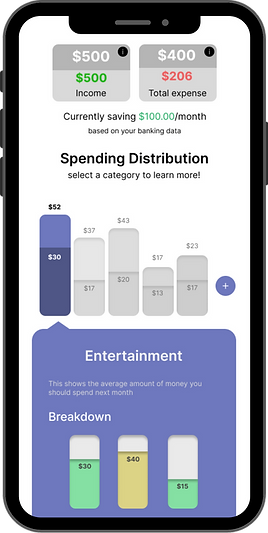
Background
Team
Duration
Fall 2024
5 months
Tools
Activites
-
Literature review
-
Interviews
-
Competitive analysis
-
Workshops
-
Testing
-
Prototyping
My Contributions
-
Led the literature review, synthesizing insights from 10+ research reports to identify key financial literacy gaps among Gen Z college students
-
Planned and facilitated the co-design workshop, and organized the discovery workshop to gather user needs and motivations
-
Conducted a competitive analysis of existing financial literacy tools, identifying market gaps and opportunities
-
Drove the ideation process and developed low- to mid-fidelity prototypes based on user research and testing feedback
-
Created all project documentation, including research summaries, workshop reports, and deliverables for stakeholders
Project Overview
How can we design engaging, personalized budgeting tools that address Gen Z college students’ lack of financial literacy and motivation to budget?
1.
2.
3.
Goals
Understand current financial habits, pain points, and motivations of Gen Z college students
Identify gaps in the financial literacy tools marke
Design an intuitive, integrated budgeting feature that encourages consistent use and healthier financial behaviors
What problem
did we solve?
-
Knowledge & motivation gap
-
Many college students lack budgeting knowledge and motivation, leading to impulsive spending and poor financial habits.
-
-
Tool engagement gap
-
While numerous financial tools exist, they often fail to engage this demographic, features are either too complex, scattered across multiple platforms, or lack personalization.
-
The Gen-Z population often struggles with financial literacy. Therefore, we seek to to identify users’ behaviors, habits, and knowledge regarding financial literacy, habits and struggles.
Who are we solving for and why?
Meet Sam!
Sam is a student at Purdue University and is studying computer science. She took out a loan to pay for her studies and thinks she should keep track of her finances.
Sam does not have a good understanding of financial literacy, she budgets by trying not to spend too much money each week. She knows that different tools exist but she simply doesn’t have any motivation to do so.
Current Experience
When our user group opens up their bank account to begin thinking about a budget, they are instantly presented with a variety of numbers and information. It is especially overwhelming for novice users such as Sam.
“Where should I start with?”
-User A interview
“I want something that does the stuff for me”
-User B interview
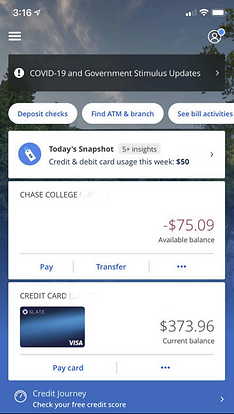

Goal features focus more on long-term goal setting rather than smaller, more actionable steps
-
Jargon languages that college students don't understand
Sam heard that she should be budgeting, but when she opened her bank account she felt
-
overwhelmed
-
confused
-
anxious
found through research activities
Milestone 1
Identifying relevant users and beginning to explore the user journey
Understand the attitudes and behaviors college students have towards personal financial literacy topics such as budgeting, taxes, spending, investing, etc.
Understand the knowledge gaps college students have towards financial literacy topics such as budgeting, taxes, spending, investing, etc.
Research
We researched Gen Z college students’ financial habits through literature reviews, competitive analysis, and interviews, uncovering low financial literacy, limited motivation to budget, and emotional triggers driving impulsive spending. These insights shaped our personas and guided our design focus.
Literature Review
Summarized 10+ research reports; findings revealed low financial knowledge, impulsive spending habits, and limited use of existing tools.
User Interviews
“I know I should be budgeting and investing, but I don’t know what to invest, or how to even do it. Is there like a website or something?”
Persona Development
Created persona which represents common financial literacy levels and motivations. These guided design priorities by highlighting distinct needs in budgeting support and tool engagement.
We gained foundational understanding of Generation Z college students' attitudes, behaviors, and knowledge regarding financial literacy. From speaking with our user group, we were able to identify key interests among this demographic, particularly in investment tools, while also revealing a prominent need for budgeting assistance.
Milestone 2
Uncovering what’s missing from today’s financial tools
Identify Common Problems and Pain Points in Financial Literacy Tools
Identify where we can implement solutions
Begin Ideation, Lo-Fi Designs, and Testing
Different Directions
Research showed that our user group, such as Sam, had a particular interest in investing, which was the initial design idea for our solution. However, we interviewed experts in the field which caused us to pivot.
“Investing is important—but students need a strong foundation first. Without a budget, they’re not ready.”
It became clear that since Sam was financially illiterate, they were not prioritizing budgeting. We decided to focus on enabling Sam to become more confident with budgeting, which would then allow her to eventually begin investing.
Competitive Analysis
A competitive analysis was conducted to discover existing gaps in the market for financial budgeting, such as Rocket Money, Acorns, etc.
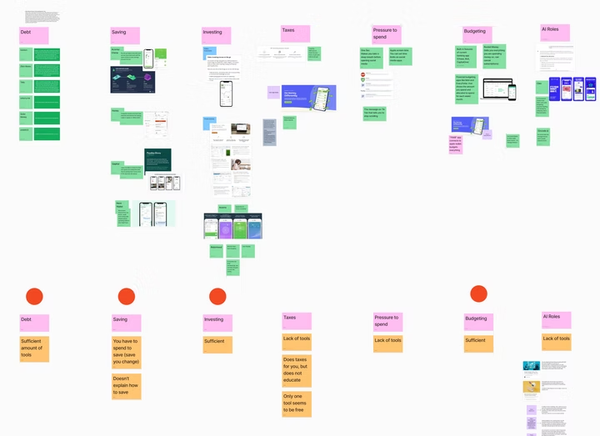
Key Insights
-
Majority of tools did not integrate into day-to-day lives
-
Features such as long-term planning were ignored
-
Tools made user feel bad about themselves, were overly complicated, and not engaging
-
Lack of personalization and motivation
2 workshops were then conducted, a discovery followed by a co-design, building on insights from one session to the next. 30+ users attended in total.
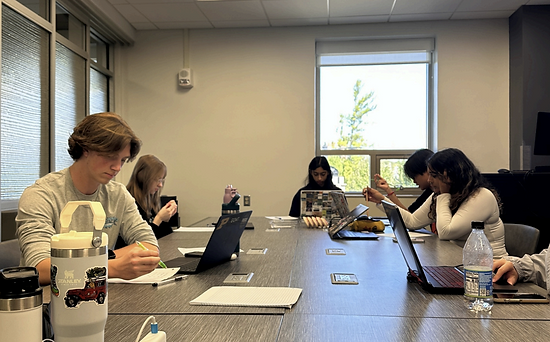
Discovery Workshop
Understand our user groups behaviors, attitudes, and motivations towards budgeting
-
Lack of knowledge and understanding of budgeting
-
Do not feel motivated to budget, but feel like it could be important
-
Could be motivated by external forces like monetary incentives, but are unsure.
“I just try not to spend money. Like if I want to go out with my friends on Saturday, I try not to buy anything during the week. It makes me sad looking at my bank account.”
-Participant
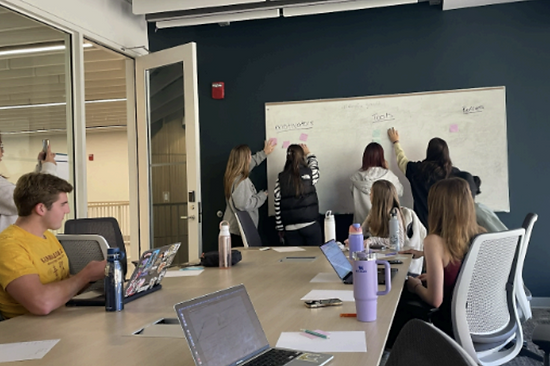
Co-Design Workshop
Collaboratively explore user motivations, challenges, and ideas related to budgeting and financial management
-
Beneficial if features were within their current bank app
-
Would like the features to be straight forward, easy to use without requiring a lot of knowledge or calculations
“I get way too much anxiety trying to sift through my own account and make a budget”
-Participant
Below, you will see the responses that were collected during the co-design workshop that answer the question of what prevents them from budgeting, what tools they would find useful, and what would motivate them to budget.
Barriers
Different expenses each month
Takes too long, too much math
Stressful to do by yourself
College life/too busy
Tools
Notification when near budget
Built-in calculator
Appears on phone without opening app
Needs to do it for me
Motivators
Minimize debt
Save money to spend on important items
Being able to hang out with friends
Financial security
Next steps
-
From our interviews and co-design, we learned that Sam does not want to download another app
-
There are already so many different apps available, they are not be utilized for a reason
-
-
Sam has no motivation, she just wants to see what she needs to do
-
Everyone e in the co-design stated that they would want this tool within their bank app
Milestone 3
What is an applicable way to transform our insights into actionable designs? How do we integrate trust?
Create Mid-Fidelity Designs
Test and iterate
Ideation
During the co-design, participants were asked to draw a tool that would be most used by themselves. From these sketches, we were able to brainstorm and iterate using our previous insights, we ended with 2 main ideas.

Receipt Scanner + Cashback
(existing apps on market)

Ai budgeting assistant integrated into existing banking app
Different Directions
Concept testing was conducted to determine which tool would be most effective
Receipt Scanner
-
Like receiving cash back and easy to understand
-
However, users hardly save receipts and would be easy to forget to use
Ai assistant
-
Visuals of spending habits determined to be useful, and optional for manual budgeting or AI
-
However, lack of trust with AI
The AI solution was selected in the end based on user feedback, but more importantly, it had stronger rationale from our research, workshops, and competitive analysis.
There are already apps with receipt scanning that most people tend to download and then forget about. The AI solution would be able to automatically create a personalized budget within minutes, reducing many obstacles that our user group faces in creating a budget.
Testing and Final Design
A prototype was created and then concept tested with users to determine how effective it was portrayed as. Initial reactions were positive, participants stating they appreciated how straight forward it was and saw potential.
However, we also discovered unexpected pain points. Certain aspects were causing confusion and others lacked a sense of trust with allowing AI to access bank information.
This feedback prompted a strategic pause to re-evaluate how to make the tool feel clearer, more approachable, and genuinely supportive.
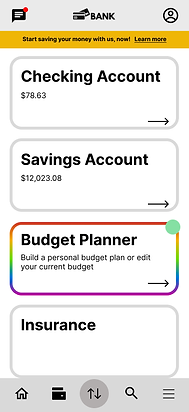
Multiple entrances to feature for discoverability
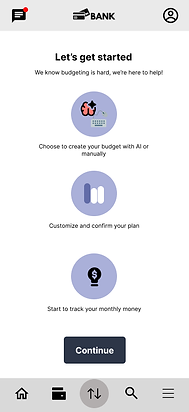
Step-by-step description of how our tool works written in non-jargoning language to help users gain a sense of understanding and trust

Detailed information on how AI works would be provided for improved transparency
Users get to choose between AI-assisted vs. manual input.
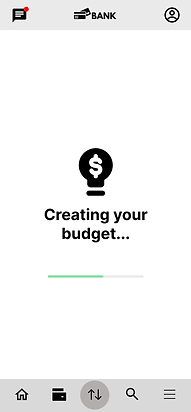
For AI assistant, the AI would generate a spending plan based on users’ historic data, while on manual mode users could make a spending plan from scratch

Budget breakdown highlighting the monthly projected income and expenses gathered by the AI
Categories suggested by AI based on past spending habits

User could edit or delete an AI generated category, allowing for personalization

Access to current budget plan and see income and total expenses for the upcoming month
With the breakdown, users could keep track of their current spending more easily through visualization, as well as gradually get to understand their financial habits
How does our solution help?